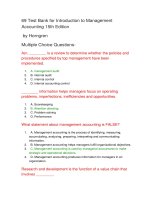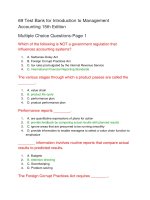R19 currency management introduction
Bạn đang xem bản rút gọn của tài liệu. Xem và tải ngay bản đầy đủ của tài liệu tại đây (1.54 MB, 55 trang )
Reading 19
Currency Management: An Introduction
www.irfanullah.co
Graphs, charts, tables, examples, and figures are copyright 2014, CFA Institute. Reproduced
and republished with permission from CFA Institute. All rights reserved.
Overview
1.
2.
3.
4.
5.
6.
7.
Introduction
Review of Foreign Exchange Rates
Currency Risk and Portfolio Return and Risk
Currency Management: Strategic Decisions
Currency Management: Tactical Decisions
Tools of Currency Management
Currency Management for Emerging Market Currencies
www.irfanullah.co
2
2. Review of Foreign Exchange Rates
•
In professional FX markets, currencies are identified by standard three-letter codes, and
quoted in terms of a price and a base currency (P/B).
•
The spot exchange rate is typically for T + 2 delivery, and forward rates are for delivery for
later periods. Both spot and forward rates are quoted in terms of a bid–offer price.
Forward rates are quoted in terms of the spot rate plus forward points.
•
An FX swap is a simultaneous spot and forward transaction; one leg of the swap is buying
the base currency and the other is selling it. FX swaps are used to renew outstanding
forward contracts once they mature, to “roll them forward.”
•
A hedge ratio is the ratio of the nominal value of the derivatives contract used as a hedge
to the market value of the hedged asset.
www.irfanullah.co
3
3. Currency Risk and Portfolio Return and Risk
1. Return Decomposition
2. Volatility Decomposition
www.irfanullah.co
4
3.1 Return Decomposition
• Domestic Asset and Domestic Currency
• Foreign Asset and Foreign Currency
• RDC = (1+RFC)(1+RFX) – 1
www.irfanullah.co
5
3.2 Volatility Decomposition
www.irfanullah.co
6
Example 1: Portfolio Risk and Return Calculations
www.irfanullah.co
7
www.irfanullah.co
8
4. Currency Management: Strategic Decisions
Client
Objectives and
Constraints
1.
2.
3.
4.
5.
Currency
Management Plan
Market Facts
The Investment Policy Statement
The Portfolio Optimization Problem
Choice of Currency Exposures
Locating the Portfolio along the Currency Risk Spectrum
Formulating a Client-Appropriate Currency Management Program
www.irfanullah.co
9
4.1 Investment Policy Statement
The currency risk management segment of the IPS could cover:
•
•
•
•
•
target proportion of currency exposure to be passively hedged
latitude for active currency management around this target
frequency of hedge rebalancing
currency hedge performance benchmark to be used
hedging tools permitted (types of forward and option contracts)
Currency management should be conducted within IPS-mandated parameters
www.irfanullah.co
10
4.2 The Portfolio Optimization Problem
• Optimize foreign currency asset and FX exposures
• Optimization of a multi-currency portfolio of foreign assets involves
selecting portfolio weights that locate the portfolio on the efficient frontier
of the trade-off between risk and expected return defined in terms of the
investor’s domestic currency
• Many portfolio managers handle asset allocation with currency risk as a
two-step process:
1.
2.
portfolio optimization over fully hedged returns
selection of active currency exposure
www.irfanullah.co
11
4.3 Choice of Currency Exposures
Degree of currency exposure spans a spectrum from being fully hedged to
actively trading currencies
• Diversification considerations
– Investment time horizon
– Fixed income versus equity investments
• Cost considerations
– Trading costs: bid-ask spread, option premiums, administrative infrastructure for
currency trading
– Opportunity costs: missing advantageous currency movements
• 50% hedge ratio: split the difference
www.irfanullah.co
12
4.4 Locating the Portfolio along the Currency Risk
Spectrum
Passive Hedging:
Keep the portfolio’s
currency exposures
close, if not equal
to, those of a
benchmark
portfolio used to
evaluate
performance; rulesbased approach and
removes almost all
discretion from the
portfolio manager.
Discretionary
Hedging:
Measure performance
against a “neutral”
benchmark portfolio.
The portfolio manager
has some limited
discretion on how far
to allow actual
portfolio risk
exposures to vary
from the neutral
position.
Active Currency
Management:
Portfolio manager
is allowed to
express directional
opinions on
exchange rates,
but is nonetheless
kept within
mandated risk
limits.
www.irfanullah.co
Currency Overlay:
Active currency
management
conducted by
external, FXspecialized subadvisors to the
portfolio.
Note: This term is
used differently by
different sources.
13
Example 2: Currency Overlay
Windhoek Capital Management is a South Africa-based investment manager that runs the Conservative Value
Fund, which has a mandate to avoid all currency risk in the portfolio. The firm is considering engaging a currency
overlay manager to help with managing the foreign exchange exposures of this investment vehicle. Windhoek
does not consider itself to have the in-house expertise to manage FX risk. Brixworth & St. Ives Asset
Management is a U.K.-based investment manager, and runs the Aggressive Growth Fund. This fund is heavily
weighted toward emerging market equities, but also has a mandate to seek out inefficiencies in the global
foreign exchange market and exploit these for profit. Although Brixworth & St. Ives manages the currency
hedges for all of its investment funds in-house, it is also considering engaging a currency overlay manager.
www.irfanullah.co
14
Example 2: Currency Overlay (Cont…)
www.irfanullah.co
15
Example 2: Currency Overlay (Solution)
www.irfanullah.co
16
4.5 Formulating a Client-Appropriate Currency
Management Program
The strategic currency positioning of the portfolio, as encoded in the IPS, should be biased
toward a more-fully hedged currency management program the more
•
•
•
•
•
•
•
short term the investment objectives of the portfolio;
risk averse the beneficial owners of the portfolio are (and impervious to ex post regret over
missed opportunities);
immediate the income and/or liquidity needs of the portfolio;
fixed-income assets are held in a foreign-currency portfolio;
cheaply a hedging program can be implemented;
volatile (i.e., risky) financial markets are;
skeptical the beneficial owners and/or management oversight committee are of the
expected benefits of active currency management.
www.irfanullah.co
17
5. Currency Management: Tactical Decisions
Tactical FX decisions are about which FX exposures to accept and manage
within the discretionary limits specified in IPS
Possible techniques include:
1. Active Currency Management Based on Economic Fundamentals
2. Active Currency Management Based on Technical Analysis
3. Active Currency Management Based on the Carry Trade
4. Active Currency Management Based on Volatility Trading
www.irfanullah.co
18
5.1 Active Currency Management Based on
Economic Fundamentals
All else equal, the base currency’s real exchange rate should appreciate if there is an upward
movement in
•
•
•
•
its long-run equilibrium real exchange rate
either its real or nominal interest rates, which
should attract foreign capital
expected foreign inflation, which should cause
the foreign currency to depreciate; and
the foreign risk premium, which should make
foreign assets less attractive compared with
the base currency nation’s domestic assets.
www.irfanullah.co
19
5.2 Active Currency Management Based on
Technical Analysis
•
Market technicians believe that in a liquid, freely traded market the historical price data
can be helpful in projecting future price movements
•
Market technicians believe that historical patterns in the price data have a tendency to
repeat, and that this repetition provides profitable trade opportunities
•
Technical analysis does not attempt to determine where market prices should trade (fair
value, as in fundamental analysis) but where they will trade.
www.irfanullah.co
20
5.3 Active Currency Management Based on the
Carry Trade
The carry trade is a trading strategy of borrowing in low-yield currencies and
investing in high-yield currencies
www.irfanullah.co
21
5.4 Active Currency Management Based on
Volatility Trading
•
Trade based on a view about future volatility of exchange rates, not the direction of
exchange rates
– Use delta hedging to hedge away the exposure to changes in FX rates
– Trader then has exposure to other Greeks, the most significant of which is vega (sensitivity of
option price to volatility underlying FX rate)
•
One simple option strategy that implements a volatility trade is a straddle, which is a
combination of both an at-the-money (ATM) put and an ATM call
•
A similar option structure is a strangle position for which a long position is buying out-ofthe-money (OTM) puts and calls with the same expiry date and the same degree of being
out of the money
www.irfanullah.co
22
Example 3: Active Strategies
www.irfanullah.co
23
www.irfanullah.co
24
www.irfanullah.co
25









